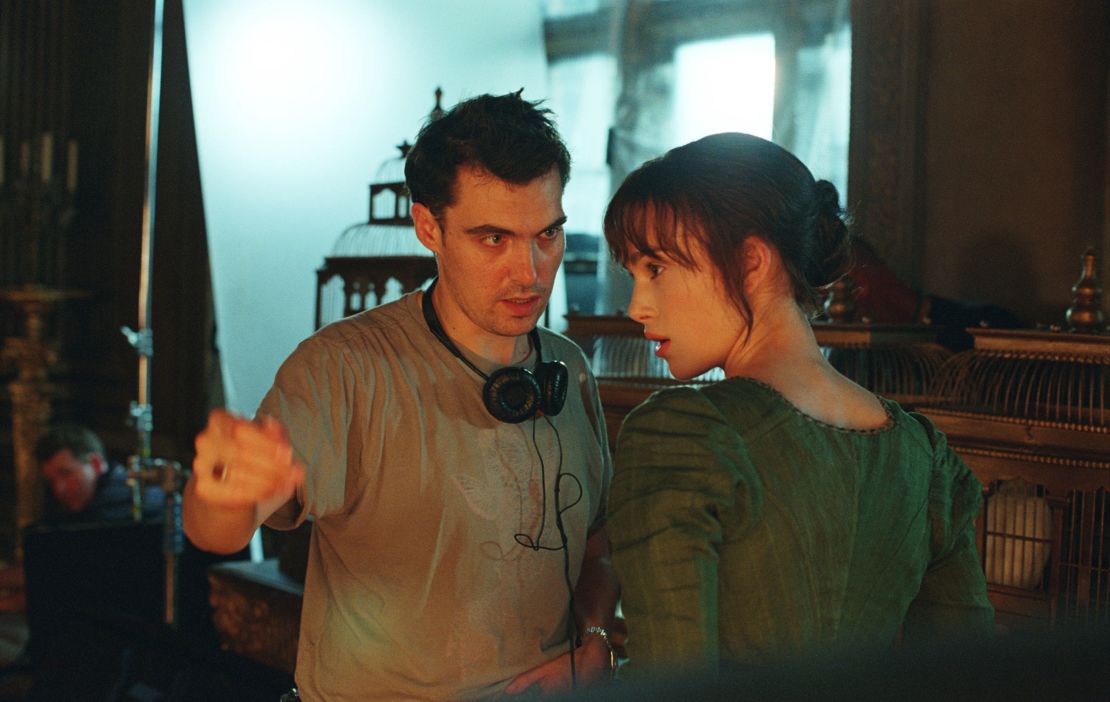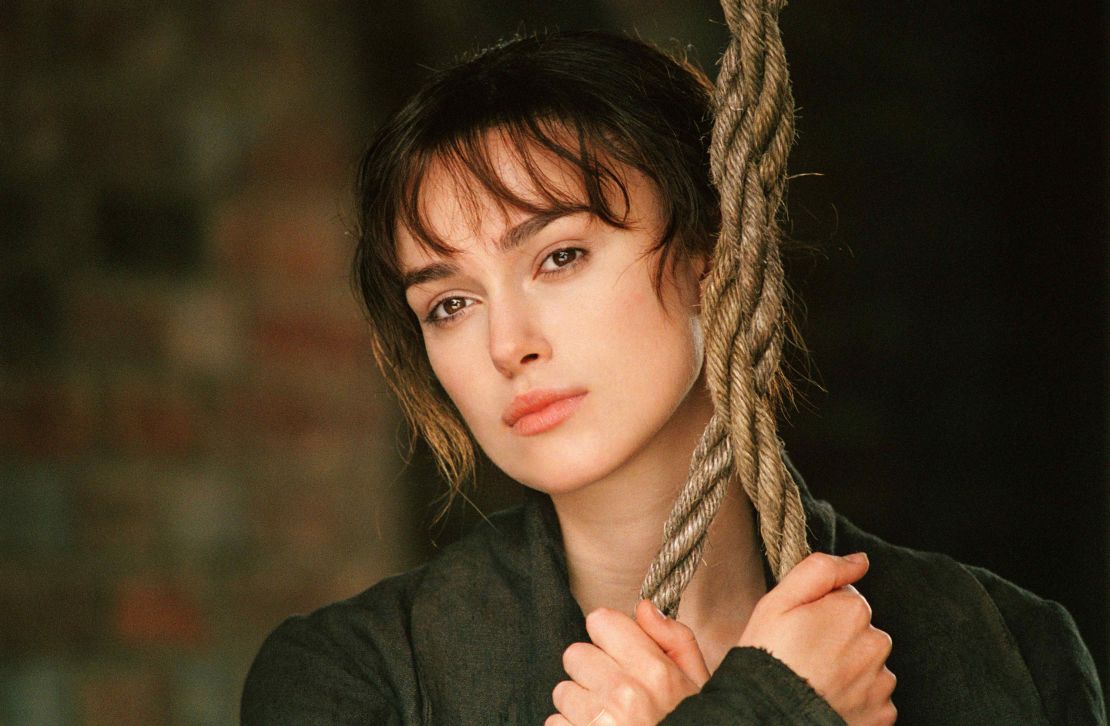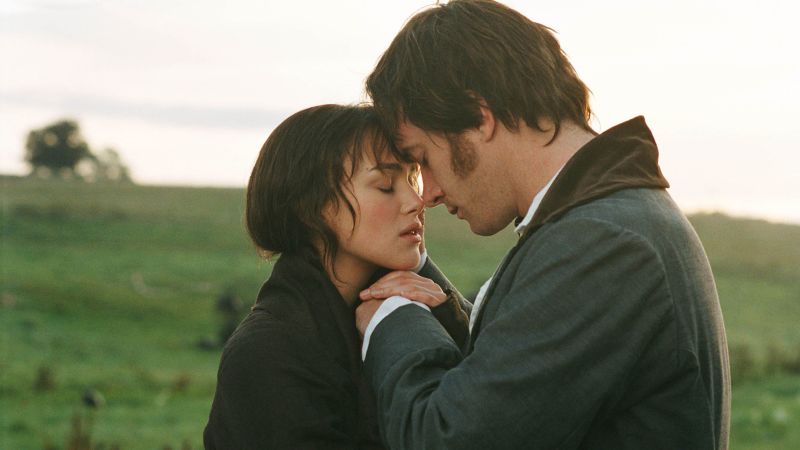CNN
—
One of the most iconic scenes in “Pride & Prejudice” (2005) is the first proposal scene.
Even those who have yet to watch the beloved movie likely have some idea of the shot. Pummelled by the rain, Mr. Darcy (Matthew Macfadyen) — wet hair flopping against his forehead — confesses his adoration to the spunky protagonist Elizabeth Bennet: “I love you, most ardently.”
Those familiar with the story know what happens next. Elizabeth (Keira Knightley) denies him and the two part ways, continuing their strained will-they-won’t-they romance. But in Jane Austen’s original novel, the scene occurs inside, empty of any steady downpours or rolling hills in the background.
And, in the novel, devoid of any hints of Mr. Darcy’s true feelings, his proposal comes as a total shock. But in director Joe Wright’s version, there are clues: held breaths, hand flexes and sexual tension thick enough to slice.
Those are just some of the elements that distinguish this version of “Pride and Prejudice” from the original novel. And it’s one of the reasons why this movie has resonated even with those who may not consider themselves fans of Austen.
Wright’s “Pride & Prejudice” is back in theaters this week in honor of its 20th anniversary. So we looked back at how, exactly, the film continues to bewitch viewers, body and soul.
While “Pride and Prejudice” has been the subject of many miniseries and modern Hallmark-esque takes, Wright’s film is considered only the second faithful film adaptation, alongside the 1940 movie starring Greer Garson and Laurence Olivier.
Until its premiere 20 years ago, the 1995 BBC miniseries starring Colin Firth as Mr. Darcy was considered the most emblematic visual adaptation. Many Austen fans embrace that version, which, at over five hours long, more strictly follows the novel.
But as seen in the proposal scene, the liberties Wright takes with the text lends to the appeal of his adaptation.

While Devoney Looser, Jane Austen scholar and author of the forthcoming “Wild for Austen,” considers the 1995 BBC miniseries to be her personal favorite adaptation, most of her students prefer the 2005 film, she said. Over the years, she’s come to see its virtues.
Wright’s approach to Mr. Darcy is one of the main differentiators. In the original text, and largely in the 1995 version, the character is standoffish and prickly. His feelings are largely hidden, hence why that first proposal comes as such a surprise, Looser said.
Macfadyen’s Darcy is different. While still aloof, he’s more brooding and tortured, and the audience clearly sees the effect Elizabeth’s presence has on him. He’s misunderstood and yearning, more than he is simply detestable. And that makes him desirable, not just to Elizabeth, but to audiences.
Wright isn’t the first to make Mr. Darcy’s character attractive to viewers; in fact, this idea of an “attractive Darcy” is found throughout many 20th century adaptations, Looser said. But Wright leans into the romantic tension even more. As viewers, we’re hooked.
“The audience has something to invest emotionally (in),” Looser said. “And, I think in terms of sexual desire in Darcy, visually.”
Note the scene when Elizabeth’s sister Jane (Rosamund Pike) falls ill at Netherfield, where Mr. Darcy and his companions are temporarily staying. When Elizabeth visits, we hear from Carolyn Bingley, off screen, that she appears “positively medieval.”
But the camera focuses on Mr. Darcy’s sight line, so we don’t see Elizabeth’s muddy dress or her dirty boots. Instead, the camera lingers on her wide eyes and her cascading hair — a stark contrast to the focus in both the book and other adaptations, Looser said. Audiences are allowed a peek into the tense and clumsy feelings Mr. Darcy holds.
And take the famous hand flex scene, so well known that distributor Focus Features is now selling T-shirts and hoodies emblazoned with Macfadyen’s outstretched hand. In the scene, Mr. Darcy is helping Elizabeth into her carriage. As she steps in, her hand still in his, he releases her palm, swivels around and strides away, while Elizabeth stares in bewilderment. Then, he flexes his hand as if he’d been shocked — a release of the emotional electricity her touch wrought.
Wright gives us that visual insight into Darcy’s mind and his feelings, Looser said, but Austen doesn’t. This tension, built throughout the film, seizes audiences’ attentions and fills even the most seemingly mundane moments with heat.

But Wright’s “Pride & Prejudice” isn’t just a love story. While many adaptations give a peek inside Darcy’s interior life, Wright extends this lens to all of the characters in the story, said Justin Smith, professor of cinema and television history at De Montfort University in Leicester, England.
Take Elizabeth’s sister Mary (Talulah Riley). When Elizabeth announces her rejection of Mr. Collins’s proposal, Wright’s camera focuses on Mary, whose face fills with a wistful expression.
“It’s almost as if she’s saying, ‘I would say yes if he asked me,’” Smith said, “And a whole back story emerges about her.”
Wright’s small windows help all the characters come to life, Smith said, in a way that doesn’t happen in other adaptations. Together, they create a rich world for viewers to fall into. Beyond the romance, Wright’s “Pride & Prejudice” could be a family tale, and who can’t relate to a nagging mom or sibling jealousy?
Today, the film lands differently
Upon its release, Wright’s “Pride & Prejudice” was a smash hit, netting more than $121 million worldwide on a $28 million budget and a cast led by two rising stars. The critic Roger Ebert famously gave the film, which went on to be nominated for four Academy Awards, four out of four stars. The soundtrack is filled with a lilting piano and birdsong; the cameras sweep over the rolling hills and lush greenery. Every frame seems like a painting.
But the rerelease comes at a very different time than the original premiere back in 2005. Movie theaters are in decline, analysts are mourning mid-budget films and romantic dramas aren’t as ubiquitous as they once were. While this context might not subtract from the beauty of the film, audiences today are approaching it with a distinct lens.

People flooded theaters to see the 1940 adaptation, which was produced during World War II as part of an effort to boost morale, said Deborah Cartmell, a professor of English at De Montfort University and an adaptations studies expert. Audiences craved that nostalgic look at an England “worth fighting for.”
A similar nostalgia could be at play today, she said.
“Watching it makes you feel really nostalgic for 20 years ago,” Cartmell said. “In these turbulent times, it’s a really reassuring tale to look at and enjoy.”
There’s also something soothing about watching two people meet and fall in love, not necessarily in the most fairytale way, but in a way that appears natural and true. Today, when much of romance is mediated through dating apps and text messages, watching face-to-face intimacy can also be nostalgic, Smith said.
“Movies remind us of the very tangible and raw nature of emotion and of human intimacy, and of actually getting to know someone in physical spaces,” Smith said. “That may sound far-fetched, but I think we may have a nostalgia for romance and courtship that predates the rituals and conventions of the digital age.”
The drama of Wright’s “Pride & Prejudice” reminds of this more organic way of meeting someone, getting to know them and tumbling into love. That, Smith said, is worth celebrating.



